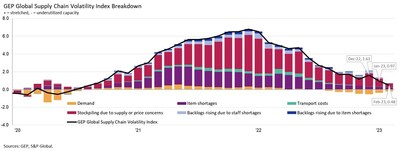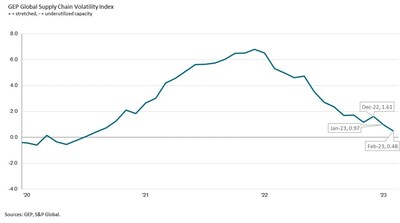DEMAND FOR COMPONENTS AND RAW MATERIALS IMPROVES IN ASIA, PUSHING UP SUPPLY AND INFLATIONARY PRESSURES: GEP GLOBAL SUPPLY CHAIN VOLATILITY INDEX
The GEP Global Supply Chain Volatility Index, released on March 13, 2023, indicates a continued recovery in global supply chains, with a February score of 0.48, a significant drop from 0.97 in January, the lowest since August 2020. Demand for raw materials remains weak but has improved in North America and Asia, where purchasing activity has risen for the first time since July 2022. Additionally, companies are reducing safety stock levels due to longer lead times and improved materials supply. Labor shortages are minimal in affecting supplier capacities, and transportation costs have stabilized. The latest trends suggest ongoing challenges, particularly in the U.K.
- GEP Global Supply Chain Volatility Index decreased to 0.48 in February from 0.97 in January.
- Demand conditions are improving in North America and Asia, with increased purchasing reported in Asia.
- Item shortages are at their lowest since September 2020, indicating better supply alignment.
- Global demand for raw materials and components remains depressed, particularly in the U.K.
- Europe continues to face supply chain bottlenecks despite easing pressures.
- Global demand remains depressed, but trend improving in
North America andAsia - Global supply chain volatility continues to recede. Now at its lowest level since
August 2020 - Item shortages are minimal, and businesses unwind their safety stocks to make inventories leaner
Demand for raw materials and components, while remaining depressed, especially in the
Commenting on the February data,
The key findings from February's data:
- DEMAND: Global demand for components, raw materials, commodities, and items that companies require for their goods and services remains depressed, but the trend improved during February as procurement leaders in
Asia increased purchasing. - INVENTORIES: Notably, global companies are unwinding their safety stocks as falling lead times, improved material supplies and an uncertain economic outlook prompt more businesses to make inventories leaner. Reports of stockpiling are now at their lowest in two-and-a-half years.
- LABOR SHORTAGES: Labor shortages are having little adverse effect on supplier capacity, indicating that staffing levels are sufficient to deal with workloads and demand.
- MATERIAL SHORTAGES: Business reports of item shortages are at their lowest since
September 2020 as global supply and demand forces become more aligned. - TRANSPORTATION: Global transportation costs have normalized and remain stable due to lower pressures on shipping, rail, air, and road freight.
- REGIONAL SUPPLY CHAIN VOLATILITY: Europe continues to be the greatest bottleneck for suppliers, although pressures are easing. Notably, suppliers to
U.K. and North American companies saw spare capacity rise for the first time since summer 2020.
For more information, visit www.gep.com/volatility
Note: Full historic data dating back to |
ABOUT THE GEP GLOBAL SUPPLY CHAIN VOLATILITY INDEX
The GEP Global Supply Chain Volatility Index is produced by
The headline figure is the GEP Global Supply Chain Volatility Index. This is a weighted sum of six sub-indices derived from PMI data, PMI Comments Trackers and PMI Commodity Price & Supply Indicators compiled by
The GEP Global Supply Chain Volatility Index is calculated using a weighted sum of the z-scores of the six indices. Weights are determined by analyzing the impact each component has on suppliers' delivery times through regression analysis.
The six variables used are 1) JP Morgan Global Quantity of Purchases Index, 2) All Items Supply Shortages Indicator, 3) Transport Price Pressure Indicator, and Manufacturing PMI Comments Tracker data for 4) stockpiling due to supply or price concerns, and backlogs rising due to 5) staff shortages and 6) item shortages.
A value above 0 indicates that supply chain capacity is being stretched and supply chain volatility is increasing. The further above 0, the greater the extent to which capacity is being stretched.
A value below 0 indicates that supply chain capacity is being underutilized, reducing supply chain volatility. The further below 0, the greater the extent to which capacity is being underutilized.
A Supply Chain Volatility Index is also published at a regional level for
For more information on PMI surveys, PMI Comments Trackers and PMI Commodity Price & Supply Indicators, or the GEP Supply Chain Volatility Index methodologies, please contact economics@spglobal.com.
About GEP
GEP® delivers transformative supply chain solutions that help global enterprises become more agile and resilient, operate more efficiently and effectively, gain competitive advantage, boost profitability and increase shareholder value. Fresh thinking, innovative products, unrivaled domain expertise, smart, passionate people — this is how GEP SOFTWARE™, GEP STRATEGY™ and GEP MANAGED SERVICES™ together deliver supply chain solutions of unprecedented scale, power and effectiveness. Our customers are the world's best companies, including more than 550 Fortune 500 and Global 2000 industry leaders who rely on GEP to meet ambitious strategic, financial and operational goals. A leader in multiple Gartner Magic Quadrants, GEP's cloud-native software and digital business platforms consistently win awards and recognition from industry analysts, research firms and media outlets, including Gartner, Forrester, IDC, ISG, and Spend Matters. GEP is also regularly ranked a top supply chain consulting and strategy firm, and a leading managed services provider by ALM,
About
We are widely sought after by many of the world's leading organizations to provide credit ratings, benchmarks, analytics and workflow solutions in the global capital, commodity and automotive markets. With every one of our offerings, we help the world's leading organizations plan for tomorrow, today.
About PMI
Purchasing Managers' Index™ (PMI™) surveys are now available for over 40 countries and also for key regions including the eurozone. They are the most closely watched business surveys in the world, favoured by central banks, financial markets and business decision makers for their ability to provide up-to-date, accurate and often unique monthly indicators of economic trends.
Media Contact
|
|
|
Disclaimer
The intellectual property rights to the data provided herein are owned by or licensed to
This Content was published by
![]() View original content to download multimedia:https://www.prnewswire.com/news-releases/demand-for-components-and-raw-materials-improves-in-asia-pushing-up-supply-and-inflationary-pressures-gep-global-supply-chain-volatility-index-301769504.html
View original content to download multimedia:https://www.prnewswire.com/news-releases/demand-for-components-and-raw-materials-improves-in-asia-pushing-up-supply-and-inflationary-pressures-gep-global-supply-chain-volatility-index-301769504.html
SOURCE GEP










